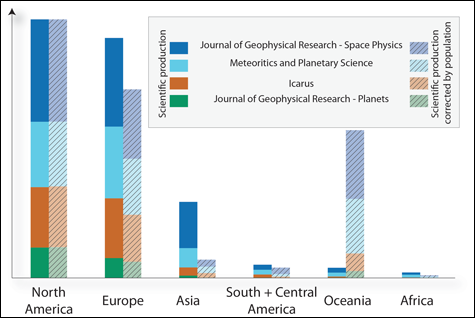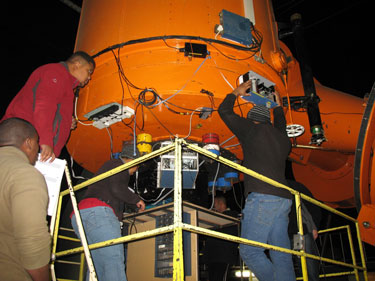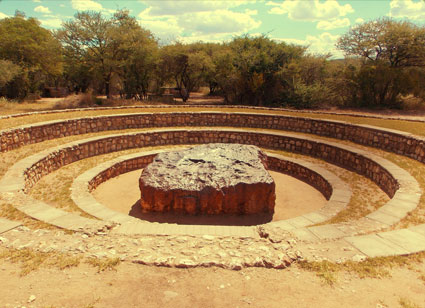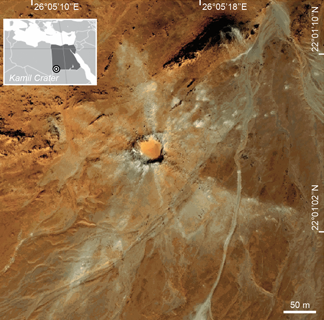Imagine a group of academic subjects that could help Africa to inspire youngsters, spur innovation, develop local economies, solve pressing problems, and even foster world peace. Can such a panacea exist?
In many areas of the world, investment in planetary and space science kick-started a wealth of development that propelled countries forward.
We strongly feel that it can. The subjects? Planetary and space sciences (PSS). In many areas of the world, investment in planetary and space science kick-started a wealth of technological development and interest in science that propelled countries forward. A survey of almost 800 researchers who published in Nature between 2005 and 2008 revealed that half of them were inspired by the Apollo missions to pursue science—and not just in astronomy or planetary sciences [Monastersky, 2009].
To elevate planetary and space science across the entire African continent, we propose the Africa Initiative for Planetary and Space Sciences, an idea that stemmed from a panel discussion during the planetary science sessions of the 35th International Geological Congress (IGC) in Cape Town, South Africa, in 2016. This discussion, along with a working dinner at IGC sponsored by the American Geophysical Union (AGU) and also our previous experiences, has inspired a series of recommendations for expanding and structuring PSS across Africa.
Why Focus on PSS in Africa?
Unlike their counterparts in North America, Europe, and Asia, African nations do not have large, dedicated (and well-funded) PSS programs that have international visibility. As a result of this and other factors, Africa-based scientific output in PSS is very low compared to the rest of the word (Figure 1).

The reasons for this are complex. Most glaringly, several countries lack a critical mass of requisite experts in science, technology, engineering, mathematics (STEM) subjects.
We see this lack as a missed opportunity. Planets, space, meteorites, and impact events capture the imagination, and the fascination for space studies may contribute to driving the younger generation toward higher education in STEM disciplines. In particular, meteorites can easily be harnessed for public outreach purposes and to train students how to use analytical equipment.
Although some programs do exist—for example, Egypt has opened 11 STEM schools across the country—a greater focus on education, from primary school through to the doctoral level, could have high rewards.
What Does Africa Need to Foster PSS education?
Students at most African high schools are not exposed to basic knowledge in astronomy and space science. We recommend a continent-wide effort to enhance teaching programs to fill these gaps.
Next, undergraduate students should be familiarized with the origin of Earth and other planets. The introduction to PSS should be the occasion to learn about the scientific value of the African impact cratering record [Reimold and Koeberl, 2014] and the wealth of scientific information gleaned from the numerous meteorites collected on the African continent. Basic courses should include stimulating practical work, such as the analysis of planetary data and the examination of meteorites. Such practical courses require the creation and curation of meteorite collections in African museums.
To consolidate resources, the few African universities that already have planetary and space science groups must commit to close interaction with key overseas partners.
African students should also have the opportunity to study space exploration techniques, become familiar with sensors used to analyze the surface and interior of planets, and learn the effects of space environment (space weather) on satellites. They should also be exposed to the research programs offered by the major space agencies to empower them with information that might offer them access or entry into such international programs.
PSS education could include training in techniques and software for processing existing and freely available satellite data. It could also include the applications of satellite imagery for land, natural resource, or crisis management and monitoring the consequences of climate change or infrastructure development on the natural environment.
To consolidate resources, the few African universities that already have emerging PSS groups must commit to close interaction with key overseas partners (universities and funding and space agencies). African students commonly move between countries and universities with diverse curricula, and these PSS programs may attract highly motivated students from neighboring countries.
Filling This Need: The Africa Initiative for Planetary and Space Sciences
We propose initial investment for a 5-year program that prioritizes M.Sc. and Ph.D. scholarships, temporary study-abroad fellowships for M.Sc. and Ph.D. candidates, and visits of junior (volunteering Ph.D. students) and senior researchers to Africa for transfer of knowledge. After a fourth-year review, the program could be renewed for another 5 years, with the longer-term goal of building a 20-year plan.

Initially, students receiving fellowships should be selected in countries with emerging groups in PSS, and the research topics should be defined in relation to local expertise and scientific priorities. The program must be advertised to ensure that the local population and political authorities are able to grasp the outcomes of new groups of pioneering academics, who will be moving Africa ahead.
The definition of research projects under this new effort should be based on local expertise and strengths. Sedimentologists could focus on Martian sedimentary sequences; petrologists and geochemists could examine planetary analogs in Africa and meteorites found in Africa to investigate the formation of extraterrestrial rocks. Space scientists could analyze the effects of space weather on technological systems in Africa. African astronomical observatories may also take advantage of specific opportunities, such as the search for and monitoring of minor bodies, comets, or exoplanets [Gillon et al., 2017].
Tapping into Africa’s Wealth of Geological History
The African geological record offers fertile ground for understanding processes on other planets.
The African geological record offers fertile ground for understanding processes on other planets. The Africa Initiative could tap into this record.
For example, planetary scientists have explored dry lakes in the Egyptian Western Desert to understand alteration signatures in the arid environment of Mars. Other planetary analogs include large meteorite impact structures, such as Vredefort Dome in South Africa and the Bosumtwi structure in Ghana, and the active volcanoes and hydrothermal systems of the East African Rift.
The African geological record extends for more than 3.5 billion years, with cratonic nuclei distributed throughout the continent offering clues to understanding the coupled evolution of the interior, surface, atmosphere, and life on a habitable planet. Astrobiological studies of the Kaapvaal Craton (southern Africa) take advantage of this age context. What is more, the postimpact sedimentary fill in the Bosumtwi and Tswaing impact structures contains long-term paleoclimatic records that offer further multidisciplinary research and educational opportunities.
Science for Society
A key thread for the Africa Initiative will be to harness PSS to help society. This project involves not only pure research but applied studies as well as conservation efforts.
Africa hosts 20 confirmed meteorite impact structures, including the largest and oldest on Earth (Vredefort, 2.02 billion years old). These structures, and specific sites therein, must be protected.

Evidence for even older impact events exists in the rock sequences of the Archean and Proterozoic in South Africa, and statistical analysis of impacts at a planetary level suggests that many more impact structures remain to be discovered on the continent. Quite a number of proposed impact sites in Africa are already awaiting ground truthing by field and laboratory work [Reimold and Koeberl, 2014].
Many impact structures worldwide are associated with natural resources [Reimold, 2005], and no country in Africa should ignore the potential of even small impact structures. Impact craters are also logical places for ecotourism activities and scientific centers (e.g., Bosumtwi, Tswaing, and Vredefort). About one sixth of the classified meteorite samples have been found in the Sahara. Hoba, the largest known meteorite, was found in Namibia and is now a national monument. Three of the five Martian meteorite falls were observed in Africa [Chennaoui Aoudjehane et al., 2012].
We hope that through the Africa Initiative, more African nations could take advantage of the clear night sky for observation of meteorite falls and of the dry conditions over a significant part of the continent for the preservation of ancient falls. We strongly feel that the curation of African meteorites in African museums for educational purposes will also foster sustainable science development on local and regional levels.

Collecting meteorites is controlled by laws in Algeria, Namibia, and South Africa, and law enforcement requires programs to educate official staff. The situation is unclear in some other African states, and we recommend that a regulatory framework be coordinated at the regional scale for efficient preservation of meteorites for scientific studies. It is our hope that through education efforts related to the Africa Initiative, such coordination can be fostered.
Projects with implications for pressing issues (e.g., climate change and space environment) or a connection with industry will also be targeted by the Africa Initiative. For instance, the study of shock deformation effects in natural impactites may serve the space industry, as it is related to the effects of impact on man-made systems by micrometeorites.
Forging Partnerships
Academic staff training in PSS is a long-term effort. Here the Africa Initiative could mirror project frameworks of other science efforts in Africa. For example, Africa Array, a research and training program dedicated to continent-wide geophysics training that is run jointly by African and North American partners, is midway through a 20-year plan. The Africa Initiative requires a similar timescale.
Our initiative will build on the grassroots networks of African researchers, starting, for instance, with the United Nations Educational, Scientific and Cultural Organization–driven African Network of Earth Science Institutions, the African Academy of Sciences, the African Association of Remote Sensing of the Environment, the Geological Society of Africa, the Young Earth Scientist Network, and the Arabian Geosciences Union. The latter launched a section on Planetary Science and Astrobiology in 2015, and perhaps the Africa Initiative could offer ways to expand this in geography and subject matter.
In West Africa, it will also be possible to rely on members of the West African Exploration Initiative (WAXI). This initiative has produced closer partnership and regional knowledge sharing between the academic world, the private sector, and geological surveys [Jessell and the WAXI team, 2016].

African networks may partner with geoscience societies. For instance, the Meteoritical Society already contributes regularly to the promotion of meteoritics science in Africa, and the European Association of Geochemistry (EAG) and the Geochemical Society (GS) have organized lecture tours by international experts in Africa (EAG-GS Outreach Program). These organizations may be solicited for outreach activities in cosmochemistry or impact studies. Europlanet, an organization with substantial experience in engaging policy makers and European citizens with planetary science, is already working with African partners to create a coordinated outreach strategy for activities related to the Danakil region in Ethiopia (as a planetary analog site). Efforts in the Africa Initiative could follow these examples.
African institutions must be made more aware of the resources readily available to them. These include data released by NASA and European Space Agency planetary missions along with tools and tutorials on how to process the data. The rise of open-access journals offers African researchers greater access to the scientific literature, which will help future researchers on the continent.
These changes facilitate the rapid integration of newcomers into the PSS community. For more ambitious teams, the development of ground facilities (similar to Africa Array’s seismometer network) that can complement existing space exploration programs may be able to attract international funding from North American, European, and Asian space agencies [e.g., Ait Moulay Larbi et al., 2015].
Endorsing the Africa Initiative for Planetary and Space Science Development
The exclusion of one fifth of the world’s population from taking part in the fascinating discoveries about our solar system impoverishes global science.
It is our conviction that the exclusion of one fifth of the world’s population from taking part in the fascinating discoveries about our solar system impoverishes global science. The identified benefits for African society as a whole justify investment into a continent-wide research and education programs in PSS. This call is also timely considering the 31 January 2016 adoption by the African Union of the African Space Policy and Strategy, which raises awareness of the central role of space science and technology in Africa’s socioeconomic development.
We declare our commitment to the development and expansion of PSS in Africa. Our effort will be focused on fundraising and elaboration of international collaborative programs, coordination at the institutional level, training M.Sc. and Ph.D. students, organization of workshops and PPS sessions at Africa-based conferences, communication, and public outreach. Already, 12 international organizations, including AGU, the Geological Society of Africa, the European Association for Geochemistry, and the Institut de Recherche pour le Développement, have endorsed the initiative.
We will attempt to mobilize domestic resources for the implementation of this policy and strategy. We are looking for a broader endorsement from the international PSS community and from key stakeholders on the African continent. People and national or international organizations who would like to support this initiative are invited to sign up here.
References
Ait Moulay Larbi, M., et al. (2015), First lunar flashes observed from Morocco (ILIAD Network): Implications for lunar seismology, Earth Moon Planets, 115, 1–21, https://doi.org/10.1007/s11038-015-9462-1.
Chennaoui Aoudjehane, H., et al. (2012), Tissint Martian meteorite: A fresh look at the interior, surface and atmosphere of Mars, Science, 338(6108), 785–788, https://doi.org/10.1126/science.1224514.
Folco, L., et al. (2010), The Kamil Crater in Egypt, Science, 329, 804, https://doi.org/10.1126/science.1190990.
Gillon, M., et al. (2017), Seven temperate terrestrial planets around the nearby ultracool dwarf star TRAPPIST-1, Nature, 542, 456–460, https://doi.org/10.1038/nature21360.
Jessell, M. W., and the WAXI team (2016), The West African Exploration Initiative—A case study in development geoscience, AusIMM Bull., October.
Monastersky, R. (2009), Shooting for the Moon, Nature, 460, 314–315, https://doi.org/10.1038/460314a.
Reimold, W. U. (2005), Economic mineral deposits in impact structures: A review, in Impact Tectonics, Impact Studies, vol. 6, edited by C. Koeberl and H. Henkel, pp. 479–552 Springer, Heidelberg, Germany.
Reimold, W. U., and C. Koeberl (2014), Impact structures in Africa: A review, J. Afr. Earth Sci., 93, 57–175, https://doi.org/10.1016/j.jafrearsci.2014.01.008.
—David Baratoux (email: [email protected]), Géosciences Environnement Toulouse, Centre National de la Recherche Scientifique (CNRS), Institut de Recherche pour le Développement, Université de Toulouse, Dakar, Senegal; also at Institut Fondamental d’Afrique Noire Cheikh Anta Diop, Dakar, Senegal; Hasnaa Chennaoui-Aoudjehane, Géosciences Appliquées à l’Ingénierie de l’Aménagement (GAIA) Laboratory, Department of Geology, Faculty of Sciences Ain Chock, Hassan II University of Casablanca, Morocco; Roger Gibson, School of Geosciences, University of Witwatersrand, Johannesburg, South Africa; Atmane Lamali, Centre de Recherche en Astrophysique et Géophysique, Département de Géophysique, Laboratoire de Géomagnétisme et Paleomagnétisme, Bouzaréah, Alger, Algeria; Wolf Uwe Reimold, Museum für Naturkunde Berlin, Germany; also at Humboldt-Universität zu Berlin, Germany; also at Geochronology Laboratory, University of Brasilia, Brazil; Marian Selorm Sapah, University of Ghana, Accra; Moulley Charaf Chabou, Institut d’Architecture et des Sciences de la Terre, Université Ferhat Abbas, Sétif, Algeria; John Bosco Habarulema, Sansa Space Science, Hermanus, South Africa; Mark W. Jessell, Center for Exploration Targeting, University of Western Australia, Perth, Australia; Aberra Mogessie, Institute of Earth Sciences, University of Graz, Austria; Zouhair Benkhaldoun, Oukaimeden Observatory, Laboratoire de Physique des Hautes Energie et Astrophysique, Université Caddi Ayad, Marakesh, Morocco; Elyvin Nkhonjera, Young Earth Scientists (YES) Network, Lilongwe, Malawi; Ndivhuwo Cecilia Mukosi, Council for Geoscience, YES, Polokwane, South Africa; Maram Kaire, Association Senegalaise pour la Promotion de l’Astronomie, Dakar, Senegal; Pierre Rochette, Centre de Recherche et d’Enseignement de Géosciences de l’Environnement, Aix-Marseille University and CNRS, Aix-en-Provence, France; Amanda Sickafoose, South African Astronomical Observatory, Cape Town; Jesús Martínez-Frías, Consejo Superior de Investigaciones Científicas, Complutense University of Madrid, Instituto de Geociencias, Spain; Axel Hofmann, Department of Geology, University of Johannesburg, South Africa; Luigi Folco, Dipartimento di Scienze della Terra, Università di Pisa, Italy; Angelo Pio Rossi, Jacobs University Bremen, Germany; Gayane Faye, Institut des Sciences de la Terre, Université Cheikh Anta Diop, Dakar, Senegal; Katrien Kolenberg, Katholieke Universiteit Leuven, Belgium; also at Physics Department, University of Antwerp, Belgium; Kelali Tekle, East African Regional Office of Astronomy for Development, Addis Ababa, Ethiopia; Djelloul Belhai, Laboratoire, Géodynamique, Géologie de l’Ingénieur et Planétologie (GGIP), Faculté des Sciences de la Terre, de la Géographie et Aménagement du Territoire, Université des sciences et de la technologie Houari-Boumédiène, Bab Ezzouar, Algeria; Meriem Elyajouri, Galaxies, Etoiles, Physique et Instrumentation (GEPI), Observatoire de Paris, Paris Sciences et Lettres (PSL) Research University, CNRS, Université Paris-Diderot, Sorbonne Paris Cité, France; Christian Koeberl, Natural History Museum Vienna and University of Vienna, Austria; and Mamdouh M. Abdeen, Geological Applications and Mineral Resources Division, National Authority for Remote Sensing and Space Sciences, Cairo, Egypt
Editor’s note: For more details on current planetary and space science projects across Africa, read the Eos.org feature article. A Reddit Science “Ask Me Anything (AMA)” focused on planetary sciences and featuring a couple authors of this piece will occur 16 June 2017. Mark your calendars!
Citation:
Baratoux, D.,Chennaoui-Aoudjehane, H.,Gibson, R.,Lamali, A.,Reimold, W. U.,Sapah, M. S.,Chabou, M. C.,Habarulema, J. B.,Jessell, M. W.,Mogessie, A.,Benkhaldoun, Z.,Nkhonjera, E.,Mukosi, N. C.,Kaire, M.,Rochette, P.,Sickafoose, A.,Martínez-Frías, J.,Hofmann, A.,Folco, L.,Rossi, A. P.,Faye, G.,Kolenberg, K.,Tekle, K.,Belhai, D.,Elyajouri, M.,Koeberl, C., and Abdeen, M. M. (2017), Africa initiative for planetary and space sciences, Eos, 98, https://doi.org/10.1029/2017EO075935. Published on 14 June 2017.
Text © 2017. The authors. CC BY-NC-ND 3.0
Except where otherwise noted, images are subject to copyright. Any reuse without express permission from the copyright owner is prohibited.

